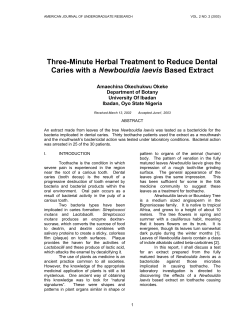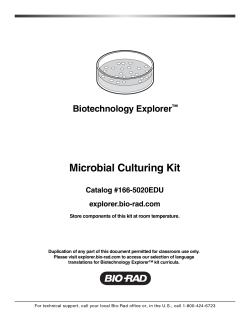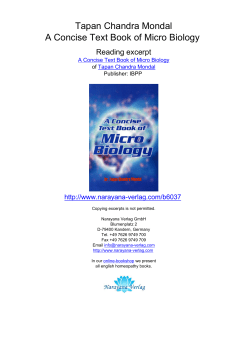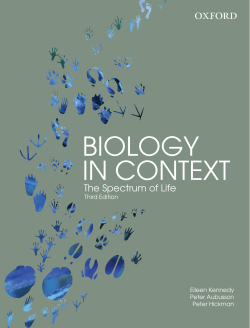
Title: “Recovery and Identification of Airborne Microorganisms in Swine
Title: “Recovery and Identification of Airborne Microorganisms in Swine Facilities Using Selective Agar and Thin Agar Layer (TAL) Resuscitation Media” - NPB#02-023 Investigators: Dr. Daniel Y. C. Fung and Beth Ann Crozier-Dodson Institution: Kansas State University Date Received: March 31, 2003 Abstract: Thin Agar Layer (TAL) medium was developed at Kansas State University to improve resuscitation of injured cells, and has been shown to result in higher recovery than selective media alone for cold, heat, salt, or acid injured cells. This experiment was designed to determine the effectiveness of the TAL method for the recovery of injured organisms in air. Eleven agar media were used for the experiment: Tryptic Soy agar (TSA), MacConkey Sorbitol agar (MSA), TAL-MSA, Baird-Parker agar (BP), TALBP, Modified Oxford agar (MOX), TAL-MOX, Xylose Lysine Sodium Desoxycholate agar (XLD), TAL-XLD, Yersinia Selective agar (CIN), and TAL-CIN. The TAL plates were prepared by pipetting 6 ml of a selective agar into a BBL RodacTM plate (65 mm x 15 mm). Selective agar was allowed to solidify, then each plate was overlaid with 6 ml of TSA. Selective agar plates were prepared by pipetting 12 ml of agar into BBL RodacTM plates and then solidifying. Samples were taken at an indoor swine facility in 5 separate locations using a BioScience SAS air sampling instrument. For each plate, 10 L of air was sampled. Three replications of the experiment were performed. The TAL method resulted in higher total and ‘Visually Typical’ counts of microorganisms on all media. In addition, 177 isolates were selected randomly and identified to test the selectivity of TAL and selective media for target organisms. This data has shown that the TAL resuscitation method is a very effective and necessary procedure for the recovery of injured organisms in air. Introduction: Microorganisms in the air of swine confinement units may have a direct impact on the health and wellbeing of the animal in different stages of growth; as well as the health of the human caretakers. Airborne microorganisms in swine confinement units have not been extensively characterized. Using a new Thin Agar Layer (TAL) Method developed at Kansas State University, we can isolate injured bacteria from air efficiently. By knowing the microbial flora of the air in swine confinement we can assess the potential risks of these bacteria to the health of the animals and human caretakers. Corrective measures can then be made. Healthier animals in pre-harvest stage will result in better meat quality and profitability for the swine industry at the market place and the entire food chain to the consumers. Many different organisms are carried by dust and can be found in air. Dust can act as a carrier by holding microorganisms and toxins. The type and amount of bacteria can be affected by environmental factors such as temperature, dust particle size, humidity, and air speed. Air sampled in close proximity to sewage treatment or animal farms can reasonably support a diverse microbiota. Some of the more common bacterial contaminants in air include Enterobacter, Pseudomonas, Proteus, Micrococcus, Enterococcus, Bacillus, and Clostridium. The ability of the previously mentioned organisms to survive drying stress is an important factor, especially organisms such as gram-positive bacilli that are capable of producing spores. Organisms with spores are more resistant to drying than those without spores. Many airborne microorganisms can cause infections and allergic reactions depending on type of bacteria and individual susceptibility. Also, these bacteria can produce toxins which can cause toxicosis. The estimation of organisms in air has been studied due to the increased concern about air quality. However, there are little data to show the recovery of injured organisms from air. Microorganisms when treated with acid, heat, cold, or chemicals may be killed (lethally injured), sublethally injured, or survive (non injured). Non-injured and sublethally injured cells can grow in non selective media (liquid or solid). However, sublethally injured cells may not be able to grow in selective agar due to additional stress by the selective agars. This may tend to under-report the presence of surviving microorganisms after treatment of foods. Injured cells can possibly recover when removed from the treatment environment. For these reasons, a resuscitation medium must be employed to recover sublethally injured cells. A recently developed method at Kansas State University called Thin Agar Layer (TAL) method involves pouring a layer of selective medium, overlaying with a nonselective medium, and then plating the sample on top of the nonselective layer and incubating normally. Injured cells then have a chance to resuscitate on the nonselective medium prior to diffusion of selective agents into the nonselective agar. Previous work has been done to evaluate TAL for recovery of heat injured cells (55° C for 15 min). These researchers found that the TAL method resulted in significantly higher counts of heat-injured Listeria monocytogenes and Salmonella typhimurium than the selective media used alone (MOX and XLD, respectively). Similar results were also obtained by Wu and Fung as the TAL method recovered higher counts of cold-injured bacteria (-20° C for 2 h; 25° C for 2 h) and acid-injured bacteria (1 or 2% acetic acid for 1, 2, or 4 min) with resulting in greater recovery using TAL compared to selective agar alone. Data from a similar air sampling project at a dairy cattle facility shows significantly higher counts on all TAL media as compared to selective media used alone. Furthermore, the bacteria identified from the agar plates are consistent with organisms found in milk and beef. 2 Based on our findings and previous work, the results from this experiment are significant as they show that this method of resuscitation should be used for recovery of injured organisms from air. There are many organisms in air that are injured and the use of selective media alone may result in underestimation and inaccurate counts of airborne bacteria. It is expected that similar resuscitation results will be obtained performing this experiment in a swine facility. Stated Objectives from Original Proposal: The objectives of this experiment were to compare 5 different selective agars with the Thin Agar Layer (TAL) version of each for the recovery of organisms from air; and identify resulting isolates to determine the microflora of air in a swine facility for food safety and public health considerations. Materials and Methods: The following media were selected for use in this experiment for recovery of total count Tryptic Soy Agar (TSA, Becton Dickinson, Sparks, MD), Escherichia coli and coliforms on MacConkey Sorbitol Agar (MSA, Becton Dickinson, Sparks, MD), TAL-MSA, Staphylococci on Baird-Parker (BP, Becton Dickinson, Sparks, MD), TAL-BP, Listeria monocytogenes on Modified Oxford Agar (MOX, Becton Dickinson, Sparks, MD), TAL-MOX, gram negative enteric bacilli on Xylose Lysine Desoxycholate Agar (XLD, Becton Dickinson, Sparks, MD), TAL-XLD, Yersinia enterocolitica on Yersinia Selective Agar (CIN, Oxoid, Inc., Ontario, Canada), and TALCIN. Selective agar. Although specific organisms listed are considered the ‘target organisms’, other bacteria may grow on the media if they can withstand the selective agents of the agar recipe. BP medium is prepared with Egg Yolk (EY) Tellurite, contains lithium chloride, and is commonly used to isolate Staphylococcus; but other organisms such as Bacillus and Corynebacterium can reduce potassium tellurite and grow on the medium. The Yersinia Selective Agar (CIN) is supplemented with cefsulodin, irgasan, and novobiocin and is very selective for Yersinia. However, it is possible that other genus such as Shigella may grow on the medium as well. MSA is commonly used to differentiate between enteropathogenic E. coli, but although most gram positive organisms are inhibited by bile salts, other gram negatives are able to grow. The MOX medium is supplemented with colistin sulfate and moxalactam and is primarily used for the isolation of L. monocytogenes. However, Bacillus and Corynebacterium are also capable of growing and hydrolyzing esculin to have the appearance of Listeria. The XLD agar is used commonly for the isolation of enteric organisms and can support growth of Enterococcus, Escherichia, Salmonella, Shigella, and Providencia, and other gram negative organisms as well. Plate preparation. The agar sampling plates used for the experiment were prepared using 65 mm x 15 mm BBL RodacTM plates (Becton Dickinson, Sparks, MD) and the following media: TSA, MSA, BP, MOX, XLD, and CIN. RodacTM plates were used as they have been the most common agar plate size used in air sampling procedures. For the plates that had selective media only, 12 ml of sterilized tempered agar were pipetted into each plate and allowed to solidify. TAL plates of each selective agar were prepared by first pipetting 6 ml of a selective medium into a RodacTM plate and allowing it to solidify. Each plate was then overlaid with 6 ml of TSA and allowed to solidify. Research has shown that preparation of TAL plates 0, 1, and 7 days in advance of use was not statistically significant in terms of injured cell resuscitation for Escherichia coli O157:H7. For this experiment, all plates were used within 24 h of preparation for practical reasons. Microbial counts. Samples were taken on three different days at an indoor cattle facility. The air samples were taken about 1.07 meters from the floor using the 3 SAS-Super100 air sampling instrument (BioScience International, Rockville, MD). All plates were exposed to 10 L of air deposited in 3 sec. After sampling, all plates were incubated at 37° C for 24 h. After 24 hours, the TSA, TAL-BP, and TAL-MOX plates were removed and all other media were allowed an additional 24 h of incubation for cell growth and resuscitation. For each location and sampling time, counts were observed and recorded. In addition to a total count of each agar plate, a ‘visually typical’ count was performed. This was done to record the appearance of organisms that look like the target organism for each agar as described by the manufacturer of the agar. The ‘visually typical’ colony appearance for each media is as follows: BP and TAL-BP (black or very dark colonies with halos), CIN and TAL-CIN (small red), MSA and TAL-MSA (pink-red or clear), MOX and TAL-MOX (dark with black halos), XLD and TAL-XLD (black). Within the facility, 5 sampling locations were chosen. All 11 media were tested at each location, and were used in random order. To begin the experiment, preliminary work was performed at a finishing barn at the swine unit at Kansas State University. This facility is an enclosed unit and houses 160 hogs. Air samples were taken in five different locations using the eleven different media. From this preliminary work 24 bacterial colonies were isolated, purified and identified using rapid method kits (API 20E; bioMerieux Vitek, Inc. and BBL Crystal Gram Positive and Negative; Becton Dickinson). The preliminary work was done to determine original microbial load of the air and give the researchers an idea of the types of bacteria predominant in the air of the swine finishing unit. Once that was assessed, the official experiment was performed. Samples were again taken at five different sampling locations using the eleven different media described. Each agar plate was incubated at 37° C for 24 h described and counted. For each plate three counts were performed: mold count, ‘visually typical’ count, and Total Plate Count (Table 1). A minimum of five bacterial colonies were chosen from each type of media for a total minimum of 50 isolates for each replication. When possible, the chosen colonies were ‘visually typical’ for the medium used. Isolate identification. A total of 177 microbial isolates were selected from selective agar and TAL plates, streaked for isolation, and identified. All isolates were gram stained with the 3-Step Gram Staining method (Becton Dickinson, Sparks, MD). Gram negative colonies were identified using API 20E (bioMerieux, Inc., Hazelwood, MO) and BBL Enterotube test kits (Becton Dickinson, Sparks, MD). API 20E is a rapid microbiological detection method which can show results of 23 biochemical reactions for the identification of Enterobacteriaceae and other non-fastidious gram negative rods. Gram positive colonies were identified using BBL CrystalTM Gram-Positive test kits. BBL Crystal Gram-Positive tests use 29 biochemical and enzymatic reactions for the identification of aerobic gram positive bacteria. To date, 177 bacterial isolates have been examined and 153 have been identified from selective agar (Table 2) and Thin Agar Layer plates (Table 3). Statistical analysis. Statistical analysis of this data was performed using Proc General Linear Model (GLM) and non-parametric sign tests. Proc GLM was performed using the SAS® system with a significance level of p 0.05 (15). The experiment in entirety was repeated 3 times. Results: Objective 1: ‘The objectives of this experiment were to compare 5 different selective agars with the Thin Agar Layer (TAL) version of each for the recovery of organisms from air’: 4 In general, TSA showed lower plates counts than other media. This is likely due to the high number of large colonies which may have covered other colonies. With the other media, the counts varied with the clear trend of TAL plates recovering higher counts than the selective media for both total count as well as ‘Visually Typical’ counts (Table 1). TAL-BP. TAL-BP plates recovered higher counts (p = 0.0009) than BP used alone. These results were not dependent on replication number (p > 0.2335) or location (p > 0.7609). As with the total count, TAL-BP recovered higher counts (p = 0.0287) of ‘visually typical’ colonies than BP used alone; and was not dependent on replication number (p > 0.3268) or location (p > 0.6136). For comparison with the selective agar, 17 isolates were randomly selected from BP and identified (Table 2). A total of 17 isolates were randomly selected from the TAL-BP plates for identification (Table 3). TAL-CIN. In the comparison of CIN and TAL-CIN, the TAL-CIN plates recovered higher numbers in eleven out of fifteen comparisons, but was found not statistically significant (p = 0.0592) than the CIN agar used alone. The TAL-CIN plates did recover significantly higher counts of ‘visually typical’ colonies (p = 0.0037). These results were found dependent on replication number (p ≤ 0.0003) but not on location (p > 0.9097). This means that the amount of VT organisms recovered depended on the day samples were taken, but not on different locations within the building sampled. For comparison with the selective agar, 20 isolates were randomly selected from CIN and identified (Table 2). A total of 17 isolates were randomly selected from the TAL-CIN plates for identification (Table 3). TAL-MSA. For the comparison of MSA and TAL-MSA, the TAL-MSA plates recovered higher counts (p = 0.0000) than the MSA agar used alone. These results were dependent on replication number (p ≤ 0.0050) but not on location (p > 0.2203). The TAL-MSA plates also recovered higher counts of ‘visually typical’ colonies (p = 0.0009). These results were also dependent on replication number (p ≤ 0.0131) but not on location (p > 0.4157). For comparison with the selective agar, 17 isolates were randomly selected from MSA and identified (Table 2). A total of 17 isolates were randomly selected from the TAL-MSA plates for identification (Table 3). TAL-MOX. In the comparison of MOX and TAL-MOX, the TAL-MOX plates recovered higher counts (p = 0.0000) than the MOX agar used alone. These results were dependent on replication number (p ≤ 0.0005) but not on location (p > 0.4396). The TAL-MOX plates also recovered higher counts (p = 0.0005) of ‘visually typical’ colonies. These results were not dependent on replication number (p > 0.1598) or location (p > 0.5019). For comparison with the selective agar, 17 isolates were randomly selected from MOX and identified (Table 2). A total of 17 isolates were randomly selected from the TAL-MOX plates for identification (Table 3). TAL-XLD. For the comparison of XLD and TAL-XLD, the TAL-XLD plates recovered higher counts (p = 0.0000) than the XLD agar used alone. These results were dependent on replication number (p < 0.0001) but not on location (p > 0.1324). The TAL-XLD plates recovered more ‘visually typical’ colonies than did XLD used alone; but was found not statistically significant (p = 0.5000); and were not dependent on replication number (p > 0.4893) or location (p > 0.8386). For comparison with the selective agar, 18 isolates were randomly selected from XLD and identified (Table 2). A total of 20 isolates were randomly selected from the TAL-XLD plates for identification (Table 3). Objective 2: ‘and identify resulting isolates to determine the microflora of air in a swine facility for food safety and public health considerations.’ 5 As expected, bacterial numbers are high and are predominantly gram-positive. Many of the identified bacteria are similar to those found in previous research. The Thin Agar Layer (TAL) resuscitation media is shown to result in slightly larger colonies and higher counts than the non-resuscitation versions (Table 1)(Figure 1). A wide range of bacteria was identified from the eleven media examined. Each genus is discussed in some detail in this section. Acinetobacter are gram-negative diplococcoid rods and are strict aerobes. They are considered nocosomial pathogens and have previously been reported as present in swine confinement air. The only media that recovered Acinetobacter in this study was XLD and TAL-XLD. Aerococcus are gram-positive cocci which are ubiquitous in nature and are also strict aerobes. Aerococcus viridans is considered an opportunistic pathogen and may be responsible for bacteremia, endocarditis, meningitis, and osteomyelitis. All media, with the exceptions of MOX and TAL-MOX recovered Aerococcus, with the highest counts recovered on CIN and TAL-CIN. Bacillus are gram-positive aerobic rods which contain pathogenic and nonpathogenic species. The only media that recovered Bacillus in this study were CIN, MOX, and TAL-MOX; with the highest amount recovered from MOX. Corynebacterium are gram-positive non-sporeforming rods. Cornynebacterium renale can be responsible for kidney abscesses in swine; and was identified in this study. This genus was not recovered on TAL-BP, TAL-CIN, TAL-MOX, MOX, or MSA; but was recovered on BP, CIN, TAL-XLD, XLD, and TAL-MSA. Enterobacter are gram-negative rods can be commonly isolated from soil and sewage. Most species are not considered important pathogens of swine disease. This genus was recovered on CIN, XLD, MSA, and TAL-MOX; with the highest amount recovered on CIN. Enterococcus are gram-positive cocci, are commonly found in fecal matter, and may be pathogenic. Furthermore, many of the species of Enterococcus are considered antibiotic resistant. The only medium which recovered this organism was CIN. Escherichia are facultatively anaerobic gram-negative rods which can be normal inhabitants of the intestine. Some species, such as Escherichia coli O157:H7, are pathogenic while Escherichia coli is not. This organism was recovered only from TALXLD. An interesting note is that the organism appeared as ‘Visually Typical’ on TALXLD; meaning that it grew as a black colony. Gardnerella are facultatively anaerobic gram-negative to gram-variable rods. Gardnerella vaginalis may cause vaginitis in women and was recovered in this study on MOX medium. Gemella are gram-negative cocci which can be aerobic or facultatively anaerobic. Gemella haemolysans is considered normal flora of humans and animals; and may be a cause of secondary infections such as endocarditis, meningitis, and pneumonia. This organism was recovered in this study on BP medium. Lactococcus are gram-positive rods which can be used for fermentation and also are implicated in meat spoilage. This organism was recovered on MOX and TAL-BP media. Leuconostoc are also gram-positive rods which can be used in fermentation. This organism was recovered on BP and TAL-XLD. Micrococcus are very small aerobic gram-positive cocci. They are commonly found in soil, water, and dust. Most strains of Micrococcus are not pathogenic, but some may be opportunist pathogens. These organisms were recovered from BP, MSA, TAL-MOX, and TAL-XLD. 6 Oerskovia are aerobic gram-positive rods, and most species are considered nonpathogenic. This organism was recovered from TAL-BP and TAL-MOX. Proteus are aerobic gram-negative rods which can be normally found in the intestinal tract of humans. These organisms can act as pathogens outside of the intestinal tract; and have been implicated in neonatal meningoencephalitis, empyema, osteomyelitis, cystitis, pyelonephritis, and prostatitis. This organism was recovered using MSA, TXD, and TAL-XLD. An interesting note is that the organism appeared as ‘Visually Typical’ on XLD and TAL-XLD; meaning that it grew as black colonies. Pseudomonas are aerobic gram-negative rods commonly found in soil, water, and decomposing matter. This organism is an opportunistic pathogen and may be deadly to those already immuno-compromised. Pseudomonas was recovered only from TAL-XLD. Serratia are aerobic gram-negative rods which can normally be found in the intestinal tract of humans, but may also cause intestinal infections. This organism was recovered from TAL-MSA. Shigella are also aerobic gram-negative rods which inhabit, and may cause infection of, the intestinal tract. This organism may also cause severe illness and death. Shigella was recovered only from XLD. Staphylococcus are aerobic gram-positive cocci which are ubiquitous. Humans are the main reservoir for these organisms. Pathogenicity ranges between species, and species are implicated in cases of toxic shock syndrome, food poisoning, intoxication. This organism was recovered from all media with the exception of CIN and MOX; with the highest amount recovered from BP. Stomatococcus are gram-positive cocci which range from aerobic to facultatively anaerobic. These organisms are considered opportunistic pathogens, primarily affecting immunocompromised persons. Stomatococcus were recovered from only MOX and TAL-MOX. Streptococcus are facultatively anaerobic gram-positive cocci. They are commonly found in humans and animals, and strains vary in their pathogenicity. Some strains, such as Streptococcus porcinus, may also be swine pathogens; and this organism was identified in this study. Streptococcus was recovered using BP, TAL-BP, MOX, and TAL-MOX; with the highest amounts recovered using TAL-MOX. In some cases, the organisms selected were unable to be identified. If the colony selected did not grow when placed on TSA, the colony was considered ‘Viable Non-Culturable’. This means that the organism did grow originally but could not be subcultured. If the organism was alive but could not be identified by the tests used in this study, the colony was considered ‘Not Identified’. This may be due to the fact that the atmosphere of an animal containment facility contains a widely diverse microbiota which is changing constantly to adapt to its environment. These adaptations may result in organisms that possess characteristics not taken into account by the current methods available. Discussion: As expected, bacterial numbers collected were high and the dominant flora from the swine confinement air was gram-positive. Overall, the Thin Agar Layer method was found to be superior in recovering organisms as compared to selective media used alone. This experiment, in addition to similar work performed by these researchers, further supports the need for resuscitation media in order to provide a true estimation of bacteria in air. Many of the bacteria that were identified are common in an air environment and were not unexpected. However, gram-negative organisms such as Shigella spp., Proteus mirabilis and Escherichia coli were not expected. This is significant as it has 7 previously been thought that gram-negative pathogens did not survive well in air and were not factors of great concern in air quality (Al-Dagal and Fung, 1990). This research is significant as it gives pork producers insight not only to the amount of bacteria in swine confinement air, but also the wide diversity of bacteria. There are very little data on the identification of bacteria in the air of swine facilities; which is why this research is important. As some of the identified bacteria may be human and animal pathogens, air can be considered as a real source of contamination for both animals and animal caretakers. Lay Interpretation: This study was designed to determine the amount of bacteria in the air of a swine confinement finishing barn using media designed to resuscitate injured organisms. In addition to knowing how much bacteria were in the air, we also wanted to identify some of the bacteria collected. This study shows that there are large numbers of bacteria in the air of the confinement facility. Our media recovered more bacteria than other media that did not resuscitate injured organisms. When identified, most of the bacteria were found to be common to air. This research shows that injured organisms must be considered so under-reporting of bacterial number does not occur. Furthermore, air should be considered a possible source of contamination for both animals and animal caretakers. Contact: Beth Ann Crozier-Dodson Kansas State University Department of Animal Sciences and Industry 1600 Midcampus Drive, Call Hall 202 Manhattan, KS 66506-1600 Tel: 785.532.1298 Fax: 785.532.5681 E-mail: bethann@ksu.edu 8 Table 1: Visually Typical and total counts (CFU/m3)of bacteria relative to media TSA TAL- BP BP Mold Count Visually Typical Count Total Count TAL- CIN CIN TAL- MOX MOX TAL- XLD XLD TAL- MSA MSA 0 0 0 587 669 234 197 847 57 747 680 NA 8,487 6,027 25,624 15,703 11,954 1,080 14 4 23,537 1432 61320 69,770 52755 26026 25,256 24,420 2,634 47,957 2,636 32,000 2,474 Note*: Counts are an average of three duplicates at five different locations for a total of fifteen plates 9 Table 2: Identification of bacteria in percent found on selective media used at the Swine facility BP CIN MOX XLD MSA Acinetobacter - - - Aerococcus 5.9 (1/17) - 45.0 (9/20) 5.0 (1/20) 5.0 (1/20) 15.0 (3/20) 5.0 (1/20) - - Bacillus Enterobacter 5.9 (1/17) - Enterococcus - Gardnerella - Gemella 5.9 (1/17) - Corynebacterium Lactococcus 11.8 (2/17) - 5.6 (1/18) 33.3 (6/18) - 11.8 (2/17) - 5.9 (1/17) - - - - - - - - 11.8 (2/17) - - 5.9 (1/17) 5.9 (1/17) - - - - - - Proteus - - Shigella - - - Staphylococcus 29.4 (5/17) - - - 5.6 (1/18) 5.6 (1/18) 22.2 (4/18) - Micrococcus 5.9 (1/17) - 11.1 (2/18) 5.6 (1/18) - 5.9 (1/17) 5.9 (1/17) - Leuconostoc - 5.9 (1/17) - 17.6 (3/17) 17.6 11.8 Streptococcus (3/17) (2/17) 11.8 20.0 17.6 5.6 Viable Non(2/17) (4/20) (3/17) (1/18) Culturable 11.8 5.0 23.5 5.6 41.2 Not Identified (2/17) (1/20) (4/17) (1/18) (7/17) Note: Within the parentheses, the numerator denotes number of organism identified out of the denominator sample number. Stomatococcus - - 10 Table 3: Identification of bacteria in percent found on TAL media used at the Swine facility TALTALTAL-MOX TALTALBP CIN XLD MSA 5.9 70.6 50 35.3 Aerococcus (1/17) (12/17) (10/20) (6/17) 23.5 Bacillus (4/17) 5.0 5.9 Corynebacterium (1/20) (1/17) 5.0 Escherichia (1/20) 5.9 Enterobacter (1/17) 5.9 Lactococcus (1/17) 5.0 Leuconostoc (1/20) 5.9 5.0 Micrococcus (1/17) (1/20) 5.9 5.9 Oerskovia (1/17) (1/17) 5.0 Proteus (1/20) 5.0 Pseudomonas (1/20) 11.8 Serratia (2/17) 41.2 17.6 11.8 10.0 23.5 Staphylococcus (7/17) (3/17) (2/17) (2/20) (4/17) 11.8 Stomatococcus (2/17) 11.8 17.6 Streptococcus (2/17) (3/17) 17.6 11.8 5.9 5.0 5.9 Viable Non(3/17) (2/17) (1/17) (1/20) (1/17) Culturable 11.8 11.8 5.0 17.6 Not Identified (2/17) (2/17) (1/20) (3/17) Note: Within the parentheses, the numerator denotes number of organism identified out of the denominator sample number. 11 Thin Agar Layer Baird-Parker Agar (TALBP) Baird-Parker Agar (BP) Figure 1: Comparison of Baird-Parker Agar (BP) and Thin Agar Layer (TAL) BP 12
© Copyright 2025





















